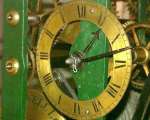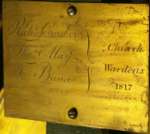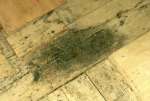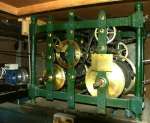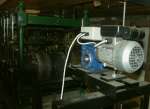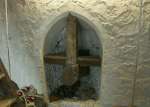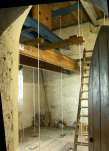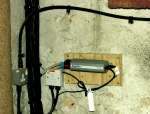Did you know? :
Wokingham Bell Foundry operated for nearly 300 years, from around 1350 until 1620 when the business moved to Chertsey.
The Clock Room
The clock room is just below the bells, and all the ropes pass through it, between the bells and ringers. The clock is suspended just below the ceiling, and wound from a raised platform. It was made by Thwaites & Reed of London in 1817. A small face shows the time, and can be turned to set the clock. It is a mirror image of a normal clock face, because it is on the back end of the shaft that drives the hands on the west dial.
The clock was originally driven by two large lead weights that fell from the pulleys on the ceiling to the ground floor in eight days, enabling the clock to be wound weekly. We are fairly sure the clock was designed like this, because there was enough wire in the drums to reach the whole way. For much of its life it would only run for five days, and had to be wound twice a week, because the weight drop stopped at the gallery floor, which was installed in the 1860s. During subsequent work (probably when the bells were rehung in 1903) one of the weight cables was routed down to the clock room floor then up to the ceiling pulley, which used up much of the spare cable. There is a large oil stained hole where the eye bolt , to which the pulley block was attached, was screwed into the floor.
Once this history was understood, it was a relatively simple job to re-route the weight cable and extend the weight shaft down into the porch . The cupboard in which it ends was already there, with a weight shaped hole in its top.
In 2005, manual clock winding ended when electric auto-winders were fitted to both the clock drive and the strike mechanism. The clock now uses much smaller weights that fall a limited distance, and are automatically re-wound many times a day. The winding handle is no longer used.
The clock's time keeping is controlled by the length of the pendulum (longer = slower) and there is a nut that can raise or lower the weight to change the effective length of the pendulum. But that is not easy t use for fine adjustments so there is a hook above the weight on which to hang metal washers, which are easy to add or remove as required. Adding a washer raises the average centre of gravity because it is above the centre of the weight, but only by a tiny amount because it is so light compared with the main weight.
The other notable feature of the clock room is the end of a roof beam that protrudes through an opening on the east wall.
The clock room also houses the pump that moves condensation from the air conditioning unit in the room below to the gutter on the roof. Up here it is out of the way but still easily accessible if needed.
Acoustics
Ringers need to be able to hear the individual strike of their own bells within the overall sound. Reverberation within the tower makes this more difficult. In 2005 the ringers exploited the fact that the sound passes through the clock room, which is between the bells and the ringers, to make a significant improvement to the sound. Old carpets were hung over the walls (see picture below) which absorb some of the sound and reduce the reverberation, and hence help to make the sound of the bells clearer when heard by the ringers below. This simple, cheap treatment proved very effective.
Pictures
Click each to enlarge and move between pictures using the arrows.

